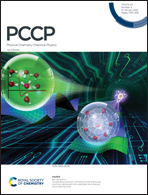New atomic-scale insights into the I/Ni(100) system: phase transitions and growth of an atomically thin NiI2 film
Abstract
We use a traditional surface science approach to create and study an atomically thin NiI2 film (a promising two-dimensional ferromagnetic material) formed on nickel substrate as a result of molecular iodine adsorption. The I/Ni(100) system was examined with scanning tunneling microscopy (STM), low energy electron diffraction (LEED) and density functional theory calculations. We found out that the iodine adsorption on Ni(100) at 300 K leads to the formation of non-equilibrium phases, whereas the adsorption at elevated temperature (≥390 K) gives rise to the thermodynamically stable phases. In both cases, a simple p(2 × 2) structure is formed at 0.25 ML. As more iodine is adsorbed at 300 K, the p(2 × 2) phase is replaced by the small coexisting domains of c(3 × 2) and c(6 × 2) phases both corresponding to the coverage of 0.33 ML, while adsorption at elevated temperature results in the formation of only one c(3 × 2) phase. At further iodine adsorption the c(3 × 2) phase transforms into the c(5 × 2) one, while the c(6 × 2) phase – into the  one both corresponding to the coverage of 0.40 ML. In addition to simple chemisorbed phases, a new shifted-row reconstruction of Ni(100) induced by iodine adsorption was discovered. At coverages exceeding 0.40 ML, we observed complex LEED patterns and superstructures in STM and assigned them to specific surface reconstructions. We also found that prolonged iodine dosing leads to the nucleation of nickel iodide islands and the growth of a 2D atomically thin iodide film partially exfoliated from the substrate.
one both corresponding to the coverage of 0.40 ML. In addition to simple chemisorbed phases, a new shifted-row reconstruction of Ni(100) induced by iodine adsorption was discovered. At coverages exceeding 0.40 ML, we observed complex LEED patterns and superstructures in STM and assigned them to specific surface reconstructions. We also found that prolonged iodine dosing leads to the nucleation of nickel iodide islands and the growth of a 2D atomically thin iodide film partially exfoliated from the substrate.

- This article is part of the themed collection: 2021 PCCP HOT Articles


 Please wait while we load your content...
Please wait while we load your content...